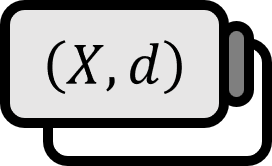Relatively Open Sets in Metric Spaces
Explanation
Let’s say there are two metric spaces $Y\subset X$. And suppose a subset $E \subset Y \subset X$ is given. If $E$ is open with respect to the entire space $X$, then by the definition of being open and interior points, $E$ remains an open set even when $Y$ is considered the entire space. This is because the situation involves a reduction of the whole set hence there is no way the neighborhood $N\subset E$ of $p\in E$ grows larger. On the contrary, the fact that $E$ is open with respect to the whole space $Y$ does not guarantee that $E$ is also open in $X$. That is, being open is not an absolute property but a relative concept determined by what the entire set is. See the example below.
Example
$E=(a,b)$, $Y=\mathbb{R}$, $X=\mathbb{R}^{2}$
By definition, $(a,b)$ is open with respect to the whole space $\mathbb{R}$. However, expanding the whole space to $\mathbb{R}^{2}$ makes it no longer an open set. This is because there exists no neighborhood $N$ of any $p \in (a,b)$ that satisfies $N\subset (a,b)$.
$E=[0,1)$, $Y=[0,\infty)$, $X=\mathbb{R}$
Just like Example 1, $[0,1)$ is an open set with respect to the whole space $[0,\infty)$. However, when the whole space is expanded to $\mathbb{R}$, $[0,1)$ is no longer an open set.
Therefore, when clarifying what it means to be open, the expression “relatively open” is used.
Definition
Given two metric spaces $X$, $Y$, let’s denote it as $E\subset Y \subset X$. If for every $p \in E$ there exists a constant $r>0$ that satisfies the following condition, then $E$ is called a relatively open set in $Y$.
$$ \begin{equation} d(p,q)<r \quad \text{and} \quad q\in Y \implies q\in E \label{definition} \end{equation} $$
The expression above doesn’t redefine openness but states ‘if $E$ is open when the entire space is considered $Y$’ in formula form. In other words, it can be explained differently as ‘it is possible to form a neighborhood of $p \in E$ that is included in $E$ with only elements in $Y$’. A theorem regarding this is presented.
Theorem
Suppose we’re given two metric spaces $X$, $Y$. And let $E \subset Y \subset X$. Then the following two propositions are equivalent.
(a) $E$ is relatively open in $Y$.
(b) There exists an open set $O_{X}$ in $X$ such that $E=Y \cap O_{X}$ holds.
This can be useful in situations where the total space is reduced. For example, consider a scenario where we were dealing with open sets such as $(-a,a)$ in the total space $X=\mathbb{R}$, but the space gets reduced to $Y=[0,\infty)$. Then, since $(-a,a)\not \subset Y$, we cannot deal with the original open sets in $Y$. At this point, according to the theorem, we can simply capture the open sets in $Y$ as $[0,a)=Y\cap (-a,a)$.
Proof
(a) $\Longrightarrow$ (b)
By assumption, for every $p \in E$ there exists a positive number $r_{p}>0$ that satisfies the following.
$$ d(p,q) <r_{p} \quad \text{and} \quad q\in Y \implies q \in E $$
Now, let’s denote the set of $q\in X$s that are $d(p,q)<r_{p}$ as $O_{X,p}$. Then, $O_{X,p}$ becomes a neighborhood of $p$ in $X$. Since a neighborhood is an open set1, $O_{X,p}$ is an open set in $X$, and since the union of open sets is an open set,
$$ O_{X}=\bigcup \limits_{p \in E}O_{X,p} $$
is an open set in $X$. It is trivial that for all $p \in E\subset Y$, $p \in O_{X,p}$ holds. Therefore, the following holds.
$$ \begin{equation} E\subset Y\cap O_{X,p} \label{eq1} \end{equation} $$
On the other hand, by the way we captured $O_{X,p}$, the following holds.
$$ \begin{equation} O_{X,p}\cap Y \subset E \label{eq2} \end{equation} $$
Therefore, by $\eqref{eq1}$, $\eqref{eq2}$,
$$ E=Y\cap O_{X,p} $$
and since $O_{X,p}$ is an open set in $X$, (a) $\Longrightarrow$ (b) holds.
(a) $\Longleftarrow$ (b)
$O_{X}$ is an open set in $X$, and let’s denote it as $E=Y\cap O_{X}$. Then, every $p\in E$ has a neighborhood that satisfies $N\subset O_{X}$. Also, by the inclusion of sets, the following holds.
$$ Y\cap N \subset E $$
This is exactly the same meaning as $\eqref{definition}$, hence $E$ is an open set in $Y$.
■
See theorem 1 ↩︎
